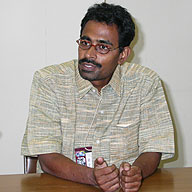An Interview with R.V. Ramani
I See These Shadow Puppeteers as the Original Filmmakers

Q: What originally motivated you to make this film?
RR: Everyone is an artist and you should be able to do what you want to do without being dictated by market forces. Unfortunately, I am constantly in conflict with that and I am trying to resist it. So I see myself in the same situation as the shadow puppeteers who are not able to function today because their entire environment has changed. Earlier there was no television, there was no cinema, and the villages were all waiting for these people to come and give their performances. Today they are not interested in them. The rhythm is not there anymore. The village rural lifestyle of India has changed drastically, the idea of pleasure and entertainment has changed completely.
I see myself in the same place. Though I practice modern media technology, I feel that I can end up in the same way as these people. Tomorrow nobody might see my film. I may not be able to make the films I want to make. And I know so many friends of mine who are documentary filmmakers who want to make films and who are not able to make them. The struggle is there all the time. So that’s the motivation for me. I see these shadow puppeteers as the original filmmakers, because without lenses, without celluloid, without technology, they created this huge spectacle on the screen with just oil lamps and people loved it.
Q: Was it your intention to get the Indian government to support shadow puppet theater as a national art form that should be preserved?
RR: When I made the film, the idea was not to preserve the puppet form. But now I feel the film is demanding that kind of activism from the government. I’ve showed the film a few times, and a lot of people from the government have volunteered to help out in whatever way they can, but I don’t know how you can really preserve any art form. If somebody wants to preserve my art form as a documentary filmmaker, I don’t know how somebody can help me. I have to help myself. If my art form has to survive, I have to help it, I have to do it. You cannot help me, it’s not possible.
The puppeteers are saying that because of cinema and television, they lost their jobs. But I don’t think that’s true. That’s not the only reason. They’ve also lost their skills in some fashion. Their own skills have gone down drastically. So today, they need to renew that. Things change, and you also need to change yourself in some fashion. So I don’t really blame the television for that, though I see a connection.
Q: You said you had over 120 hours of footage. How did you arrive at the
final length of 153 minutes?
RR: The duration of the film is one big risk I’ve taken. I discussed it with my friends and they all said, “Oh, it’s too long, who will come to watch it?” But then I thought feature films in India are like two and a half, three hours long! If they can watch that, why can’t they watch this? (laugh) I decided I’m just going to go by the logic of my approach. I tried to remove some sequences and made it one hour, but felt very uncomfortable and put it all back together.
Q: You come from a camera background. How has that affected your film style because you don’t use any voiceover narration or additional music?
RR: As a cameraman you are very conscious of your shot-taking. The basic unit of cinema is a shot, and you need to understand what is the energy of a shot and what it means to put this energy into another shot. It’s like making a house with bricks with no cement. When you use a music track or a voiceover track, you can put anything in and then cement it together. Everything will stick. But if you find a certain logical pattern of putting pieces in certain places, then they stay together and they balance themselves. So I feel the voiceover and the music track are overused in documentaries. I’m interested more in how a shot can hold another shot. I’m interested in seeing if each of the shots together can make a story without using adhesives like voiceover and overlapped sound.
(Compiled by Iyobe Kiwa)
Interviewers: Iyobe Kiwa, Hayasaka Shizuka
Photography: Sato Akari / Video: Endo Nao / 2003-10-11
